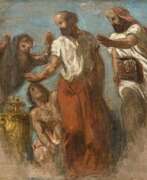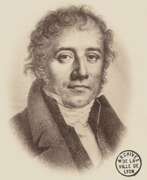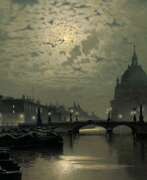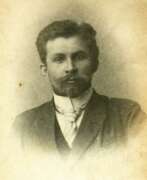Restorers 19th century


Paul Barthel was a German genre painter and portrait painter. He studied painting from 1877 at the School of Applied Arts in Dresden and then at the Royal Prussian Academy of Arts in Berlin with Julius Ehrentraut and Eugen Bracht.
Paul Barthel worked in Dresden, where he focused mainly on watercolours. In 1922 he settled in Bamberg, where he worked as a restorer.


Johann Jakob Dorner der Ältere was a German painter, engraver and restorer.
Johann Jakob Dorner the Elder specialised in historical and genre scenes. He was a professor and director of the Gallery in Munich.


Igor Emmanuilovich Grabar (Russian: И́горь Эммануи́лович Граба́рь) was a distinguished Russian painter, art historian, and museum administrator, whose contributions have left an indelible mark on the world of art. Renowned for his versatility, Grabar was not only a masterful artist but also a visionary in art preservation and education. His work reflects a deep appreciation for Russia's cultural heritage, capturing the essence of its landscapes, historical moments, and architectural beauty with a unique blend of realism and impressionism.
Grabar's significance extends beyond his paintings; he played a pivotal role in the preservation of Russian art, overseeing restoration projects and establishing guidelines that are still in use today. His efforts in cataloging and promoting Russian art helped to elevate the profile of Russian culture on the global stage. Among his well-known works, "February Azure" stands out for its captivating use of color and light, showcasing Grabar's skill in conveying the beauty of Russian winters.
As an educator and museum director, Grabar influenced generations of artists and art historians, embedding a deep respect for artistic heritage and innovation. His leadership at the Tretyakov Gallery and involvement in various art schools helped to shape the direction of Russian art in the 20th century. Grabar's legacy is not just in his artworks but also in his contributions to art education and museum practices, making him a revered figure among collectors, experts, and enthusiasts of art and antiques.
For those passionate about the rich tapestry of Russian art and culture, Igor Emmanuilovich Grabar's work remains a source of inspiration and admiration. We invite collectors and art experts to sign up for updates on new product sales and auction events related to Grabar's work. This subscription is your gateway to the world of a visionary artist whose influence continues to resonate in the art world.


Icilio Federico Joni was an Italian artist known for his exceptional talent in producing forgeries, particularly of Quattrocento paintings. Born in Siena in 1866, Joni's career in art forgery began in a gilding shop, where he honed his skills with wood, plaster, and paint. His forgeries were so convincing that they made their way into renowned collections and questioned the boundaries between counterfeit and creative artistry.
Icilio Federico Joni's works include not only paintings but also forged book covers, imitating the historic Biccherne covers from Siena. His creations, like the Madonna with Child, Saint Mary Magdalene, and Saint Sebastian, showcase his profound ability to adopt and adapt the styles of historic Sienese painters like Neroccio di Bartolomeo and Matteo di Giovanni, infusing them with his own interpretations and variations.
Despite the initial secrecy surrounding his forgeries, Icilio Federico Joni's desire for recognition led him to openly discuss his deceptions in his autobiography. His techniques in aging his creations were so meticulous that they often confused even expert art historians, adding a layer of complexity to the debate over his legacy as either a master forger or a creative genius in his own right.
Joni's story is not just a tale of deception but also a commentary on the art market's vulnerabilities and the thin lines between imitation, inspiration, and fraud. For art collectors and experts, his life and works serve as a fascinating study in the dynamics of authenticity and value in the art world.
For those intrigued by the enigmatic world of art forgeries and the exceptional craftsmanship of Icilio Federico Joni, we invite you to sign up for updates. By subscribing, you'll receive notifications about new discoveries, exhibitions, sales, and auction events related to Joni's works and the fascinating realm of art history. Stay informed and delve deeper into the intriguing stories of art and authenticity.


Joseph Nollekens was a Flemish-born British sculptor of the second half of the 18th and early 19th centuries. He is known as a Neoclassical sculptor and a master of portraiture and mythology. Nollekens was also a highly successful art dealer and skilled restorer.
At the height of his career, Joseph Nollekens became England's most sought-after sculptural portraitist and created numerous busts of dignitaries. An admirer of the sculptor's work was the British King George III. The Royal Academy of Arts granted the master the title of honorary member of this prestigious institution.
Nollekens' works nowadays decorate the halls of museums in England and Italy (where he became an artist) and are also in private collections.


Lodovico Pogliaghi is an Italian painter, sculptor and decorator. He studied at the Brera Academy under Giuseppe Bertini.
As a leading representative of eclectic academism, focused on restoring earlier classical styles, Lodovico Pogliaghi devoted himself intensively as a consultant to the Department of Antiquities and as a restorer.


Jakob Schlesinger, also Johann Jakob Schlesinger was a German painter and restorer.
Schlesinger developed a special talent for the restoration of paintings and gained a considerable reputation in this field. In particular, he devoted himself to the old German school. At first, he was working mainly for the brothers Boisserée in Heidelberg. In 1822 he received an appointment as a professor and general restorer at the Royal Museum in Berlin.


Alfons Siber, an Austrian painter and restorer, began his artistic journey as an apprentice at the Tiroler Glasmalerei-Anstalt in Innsbruck. He studied at the Academy of Fine Arts in Vienna and received several awards and scholarships. Siber settled in Hall in Tirol, where he worked as a painter and restorer. He founded the Tiroler Künstlerbund and created numerous portraits, landscapes, and large-scale church murals. Siber also carried out restoration projects.


Stepan Petrovich Yaremich (Russian: Степан Петрович Яремич) was a multifaceted Ukrainian artist and art historian, whose career spanned the late 19th and early 20th centuries. His profound contributions to art history and preservation, particularly during the tumultuous post-revolutionary period in Russia, underscore his significance beyond his work as a painter. Yaremich's expertise in Western European drawing, bolstered by his years in Paris where he amassed an impressive collection featuring masters like Watteau and Fragonard, highlighted his remarkable connoisseurship.
Educated in Kiev and Paris, Yaremich was associated with the "World of Art" movement and worked closely with figures like Alexandre Benois. He was not just an artist but a respected art expert, often involved in the restoration and cataloging of Russian and Western European art. His time at the Hermitage and Russian Museum showcased his dedication to art preservation, contributing significantly to the fields of art history and conservation.
Yaremich's artistic legacy includes landscapes of St. Petersburg, Venice, and other locales, characterized by a unique approach to color and form that distinguished his work from his contemporaries. Despite the critical acclaim, it was his behind-the-scenes work as an art historian and conservator that solidified his enduring impact on the art world.
Collectors and experts in art and antiques will find Yaremich's work both compelling and significant, underlining the importance of not only creating art but also preserving it for future generations. For updates related to Stepan Petrovich Yaremich, including sales and auction events, sign up for our newsletter. This subscription will keep you informed about the latest findings and opportunities to acquire works associated with this remarkable figure in art history.







































